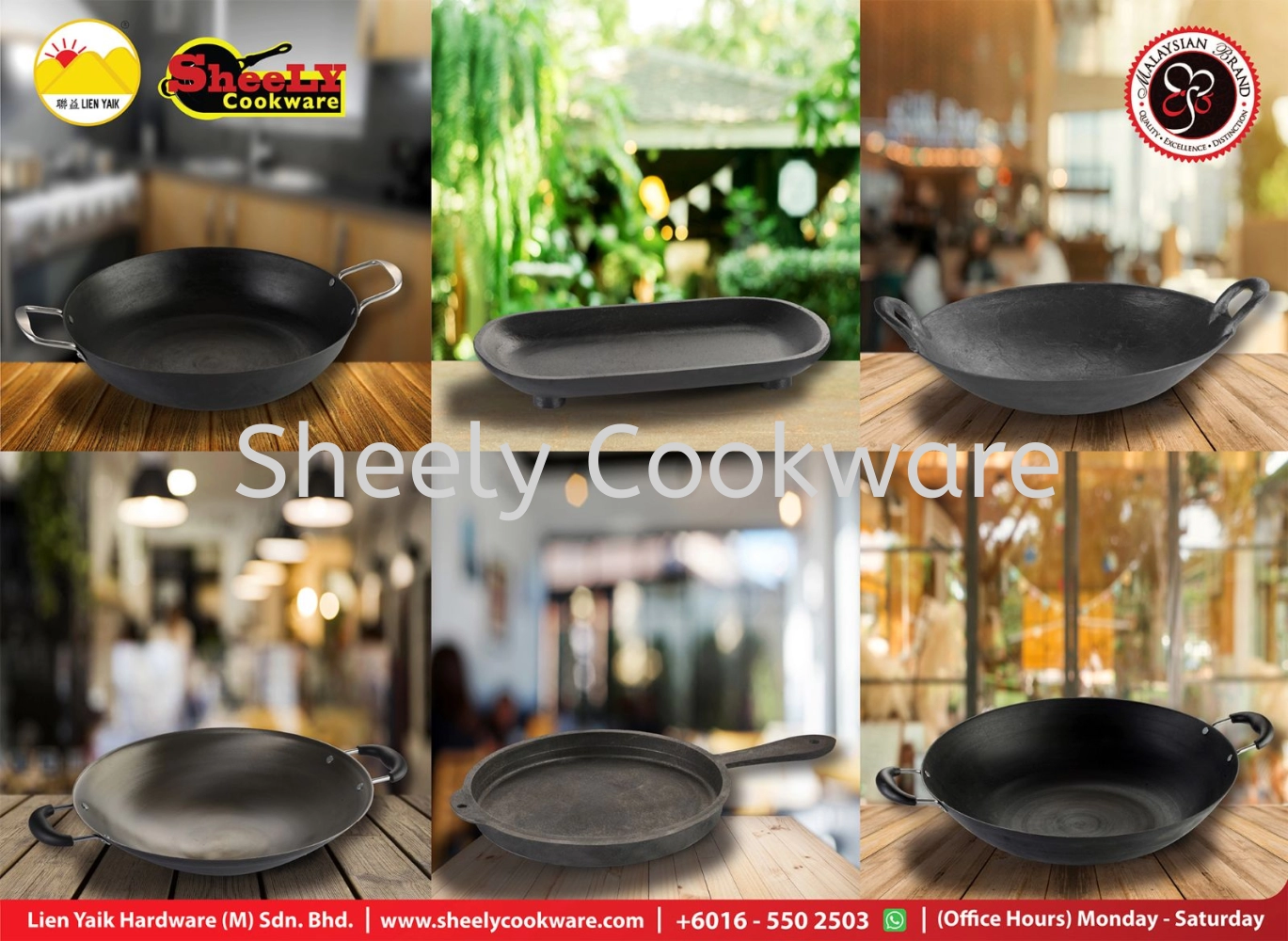WHY should you choose Cast Iron Cookware
Cast Iron Cookware: The Eco-Friendly Choice
There are many cookware options to choose from, but cast iron cookware tops them all with its many eco-friendly features and cooking benefits.
Wondering what make cast iron cooking so sustainable? Here are a few of the benefits:
- Long-lasting: Cast iron cookware is made to last multiple lifetimes. Even old and worn pieces can be refurbished with a little elbow grease, making it eco-friendly.
- Naturally Non-Stick: Cast iron is considered the original non-stick pan, minus the hazardous chemicals found in Teflon. This means good food with no side affects.
- Easy to Clean: Cast iron cookware cleans up easily with a stiff brush and hot water. No soap necessary, so less resources used.
- Easy to Use: Even heating on the stovetop, in the oven, on a grill or over a campfire means versatility, leaving you with less cookware to buy and less energy used as it retains its heat better.
- Healthy for You: Cast iron emits small amounts of iron into your food, giving you added nutrients to help you produce red blood cells and prevent anemia. As long as you're not cooking high acid foods, have a blood disease, or using a poorly sealed pan, the iron is safe and healthy.
- Affordable: It may not seem affordable when you look at a price tag of approximately $25 a piece. But when you remember than one skillet also takes the place of a casserole pan, searing pan, cornbread pan and griddle, and one Dutch Oven takes the place of a large bread pan, soup and stock pot, and deep fryer, you can start to appreciate its value. Add into that the fact that it will last you, your children and your grandchildren a lifetime, and it's a steal!
There are a few things you should know about cast iron cookware, though. It requires some unique (but simple) care.
Seasoning Cast Iron Cookware
Seasoning or curing is what creates the non-stick surface. This is accomplished when the oils or fats seep into the crevices of the pan and polymerize (harden) to create a slick surface. The more your pan is heated and cooled, the slicker this surface becomes, which is why some of the best pans often come from Grandma's house after decades of use.
Many cast iron pots and pans now come pre-seasoned by the manufacturer. This may seem like a great idea but because most of them use a soy-based oil, it may turn out to be less healthy. This is because polymerized mono- and polyunsatured fats and oils - such as canola and soybean oils - have been linked to things such as artherosclerosis and certain cancers.
So if you purchase that new, preseasoned cast iron skillet or Dutch Oven, be prepared to do some good scrubbing. Follow the same instructions used for removing rust described in the section below.
The healthy alternative to seasoning cast iron cookware?
Saturated fats! By far the best fats to use are coconut oil, palm oil and animal fats, such as bacon grease. I would personally recommend organic palm oil (found at most health food stores or online) as its smoke point is higher than coconut oil. And if you're concerned about fat you don't need to be; you're coating the pan, not eating it.
Whether you're doing it for the first time or not, follow these simple directions for seasoning cast iron cookware:
- Start by cleaning your cast iron cookware with a gentle, all-natural soap. Be sure to rinse well.
- Coat the inside and handle(s) of your cookware with the oil of your choice; you can also coat the outside if you prefer. It should be well covered, using a little more than you would for baking.
- Place your cookware upside down in a cold oven with a baking sheet beneath it. You don't want to preheat your oven as placing a cool cast iron in a hot oven can cause damage. Instead, once the cast iron is placed inside, turn the oven to 375 degrees and leave in for one hour or more. It may help to turn your kitchen fan on to vent any smells.
- After 60-90 minutes, turn the oven off and allow your dish to cool completely.
- Optionally, you can repeat the heating and cooling process 1-2 more times over the course of the day to ensure effectiveness. Repeat the entire process as needed or anytime you wash with soap. Many people repeat every time they wash to some extent, re-coating their pan and heating it up to dry.
With well-cared for pans, re-seasoning is needed less and less over the years and the older and better seasoned it is, many find they're able to wash with soap without removing the non-stick finish. (In fact, if the finish is coming off from soap, it's probably not on there very well to begin with!)
Cooking With Cast Iron
Cooking with cast iron is slightly different than cooking with other pots and pans.
First, cast iron is suppose to heat evenly, which makes it prized by cooks. That being said, we find that cold spots are possible when they aren't over direct heat. Cast iron cookware can be used in the oven, on the stovetop, in the campfire or on the grill, which is what I love most about it.
While there are lots of tips and tricks to cooking with cast iron there are a few general things you should always remember:
- Obviously, you never use cast iron in the microwave.
- Be sure your cast iron is properly seasoned. If your food sticks, you need to re-season your pans.
- Never use damaged, cracked or rusted cast iron. Read below to learn how to remove rust.
- It's important to heat your pans slowly before adding your food. If you're cooking on the stovetop, place your pan on a low heat, slowly increasing it. If you're cooking on a grill or in the oven, do the same thing on the stovetop. This shouldn't take long as cast iron conducts heat very well. If you're cooking over a campfire, place the cookware next to the fire until warm to the touch and slowly move it closer until it's in place.
- Never put cold liquids or large amounts of very cold food in a hot pan or pot. This could cause cracking of the cast iron.
- Always use hot pads! Cast iron gets very hot - even the handles.
- Use a lower heat than normal. Cast iron retains heat very well, thus needing less energy to cook thoroughly.
How to Clean Cast Iron
The first rule when learning how to clean cast iron: NEVER put cast iron in your dishwasher! Between the soap and the long contact with water, dishwashers will affect the non-stick properties of your cookware and cause rusting.
Instead, your cast iron cookware should always be handwashed. Don't worry: it's quick and simple to learn how to clean cast iron with the following 4 tips:
- No Soap: Many people never use it as it may strip the non-stick surface from your pan. However, with time and good seasoning, it is possible; just make sure you re-season as needed.
- Hot Water: Wash your pans with a stiff brush and very hot water. Capture warmup water in a dish to cook with later or water plants.
- As Needed: Only use steel wool scrubbers if absolutely necessary. Optionally, you can also boil water and half a cup of baking soda in your pan or skillet for a deeper clean. Be sure to re-season after you wash with steel wool or soap or after boiling baking soda.
- Dry Well: Leftover water will lead to rusting. You can be certain to prevent this by placing it on the stovetop or in the oven to dry it completely. I like to add a bit of cooking oil before I do this for a little extra non-stick love.
How To Remove Rust from Cast Iron
Cast iron is long-lasting and incredibly durable. So if you ever find an old piece free of cracks or chips at a garage sale or secondhand store, grab it! Poorly taken care of cast iron can still be refurbished and will last you a lifetime.
You can easily remove rust from cast iron and refurbish uneven surfaces with the following steps:
- Cut half a lemon and sprinkle a good amount of coarse salt over the damaged areas. Use the lemon to scrub the salt over the cookware very well to remove as much rust as possible. If you don't have lemon you can also use a stiff brush and small amounts of white vinegar. However, it's important you never leave lemon juice or vinegar on the cookware for too long or it will corrode more than just the rust; it will corrode the pan itself.
- For really stubborn areas you can use steel wool. But use caution so as not to cause too much wear on the pan.
- For really, really bad cookware, like the stuff you find buried at a junk sale, it might be helpful to grind it down using a sander to remove all of the previous finish, any rust, and any flakes. This will take a lot of seasoning to return it to its non-stick surface, though, so be patient.
- Follow up by washing with an all-natural soap, hot water, and stiff brush. Then rinse well with hot water only to remove any dust or residue particles.
- After you've removed all the rust and damage from your cast iron cookware as possible, you'll need to follow up with a seasoning instructions described above.
What About Enameled Cast Iron Cookware?
This article focuses on traditional cast iron, so it's important to point out that enamel cookware is different.
Enameled cast iron is cast iron cookware with an enamel glaze. There are some benefits to enameled cast iron, such as a feeling of deeper cleaning with the ability to use soap, and no need for seasoning or worry about rusting.
However, there are also some drawbacks. Other than the additional cost, it also doesn't withstand as high of temperatures as traditional cast iron and it is not non-stick. And although porcelain is considered safe, the process of enameling can sometimes contain chemicals or processing that could raise objections.
13 May 2022









